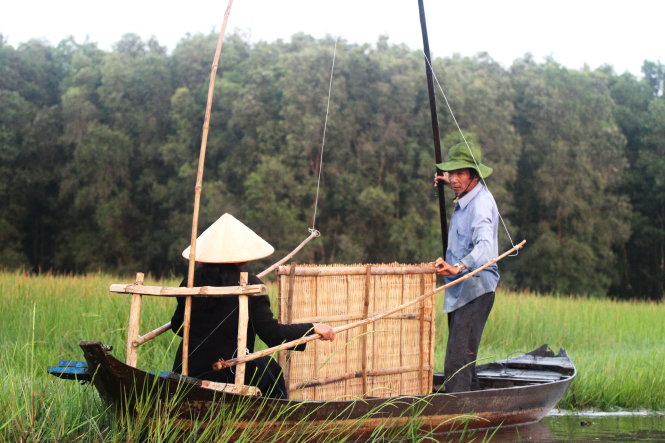To harvest ‘ghost rice,’ which is a species of wild rice, farmers have to leave for the paddy fields at midnight.
>> ‘Ghost rice’ in Vietnam – P1: Searching for the ancestry of present grains
Many farmers often joke that it is the time to go out and catch ‘ghosts.’
Harvesting ‘ghost rice’ finishes before sunrise – the moment ripe grains automatically fall from the stems onto the ground.
‘Ghost rice’ plants blossom once a year, with grains becoming ripe around ten days after blossom.
This often occurs from October to November when floodwaters begin receding.
A night trip to harvest ‘ghost rice’
Tuoi Tre (Youth) newspaper journalists followed Tran Van Luong, a 57-year-old farmer in Phu Duc Commune in Tam Nong District of the Mekong Delta province of Dong Thap, on a boat to harvest ‘ghost rice’ at 3:00 am.
It happened in total darkness.
Farmers could not pluck grains directly from the stems of ‘ghost rice’ plants as done with normal rice species because the grains fall from the stems after only a very light impact.
The way of harvesting ‘ghost rice’ is special and has remained unchanged in the region for decades.
Farmers install a 1m-tall blind at the center and along the length of a boat. At the prow, they plant two high poles vertically, each holding a rod via a long string.
A farmer sitting at the back of the boat controls the other ends of the rods so that the two lie on both sides of the boat and parallel to the water surface.
A farmer sitting at the front prow rows the boat between bushes of ‘ghost rice’ and the one behind controls the two rods to pull the ‘ghost rice’ stems into the blind.
On touching the blind, the ripe grains fall down into the boat.
In the 1970s and 1980s, a period ravaged by high floods, residents in Tam Nong would survive thanks to the wild rice species.
A boat could reap up to 30kg of ‘ghost rice’ a day.
After being harvested, the grains are soaked under water for three days so that the tail of the grain falls off in preparation for husking.
Research by Japanese experts
Dozens of Japanese researchers have visited Vietnam to collect samples of ‘ghost rice’ since 2006, with two of the researchers awarded doctorates based on their theses on the grain. The Japanese Ministry of Agriculture, Forestry and Fisheries and the Japanese Ministry of Education, Culture, Sports, Science and Technology have cooperated with the Mekong Delta Rice Institute in Vietnam for research into ‘ghost rice.’
Japan has no ‘ghost rice,’ and their scientists have been very enthusiastic about studying the wild rice, said Professor and Doctor Nguyen Thi Lang from the Mekong Delta Rice Institute.
Some research groups have visited Vietnam two or three times a year for their study.
“In an email, Japanese researchers showed me that the DNA of the ‘ghost rice’ in Vietnam is quite different from other species of ‘ghost rice’ in the world,” Prof. Lang said.
“And they are very happy about this discovery.”
The study of the genes of Vietnamese ‘ghost rice’ is to prepare for future climate change since the rice variety can adapt well to the natural environment, the academic explained.
Like us on Facebook or follow us on Twitter to get the latest news about Vietnam!



















































